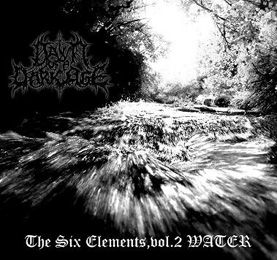
In June 2014, Dawn Of A Dark Age released their first chapter of a six-piece concept about the six elements. Six? Well, actually, this hexaptych will deal with five elements, i.e. earth, water, fire, air and spirit, each sonically defined in an own album, with the sixth part being some general conclusion. Band founder and multi-instrumentalist Vittorio ‘Eurynomos’ Sabelli (music and lyrics, production, guitars, bass, drums and percussions, clean vocals, clarinet, alto and baritone sax, piano, keyboards and programming) and experienced lead vocalist Pierluigi ‘Buran’ D’Amario (and this time some guests and session players, such as viola / violin player P-Kast, by the way; also Marcello Malatesta, who takes care of the mastering again, performs some additional keyboards & FX) will release one chronicle each six months, with The Six Elements, vol. 1 EARTH being the first one, released six months ago indeed. For the review on this interesting first opus, check the update on July 20th 2014.
The Six Elements, vol. 2 WATER is the next chapter, dealing with the element water (but I guess you knew that). Once again, it lasts for thirty six minutes, and it smoothly goes on where the first album came to an end. I did foresee a nice future to come after that debut, and well, I am not disappointed at all. The lyrical side deals with nature and its forces, as well as humanity, despair etc., yet sort of translated in a meta-language, symbolised by ‘water’ in all its aspects. Water as archetype for both birth (life) and death, and some historic and geographic information; this gets expressed as well by the black and white pictures of this limited album (100 copies).
In general, this one too is some mishmash of different genres, with loads of variation throughout the whole album, and for each aspect presented. That’s clear as from the intro, which starts with the sound of water (waves at a shore). After about one minute, The Gates Of Hell (In The Deepest Dark Abyss) shows up with synths, programmed drums and violin, soon joined by softly sung clean vocals (by a friend of them, called Malak) and some whispers. It reminds me of some mixture of ethereal Post-Rock and ambient Neo-Classical. After a violin-intermezzo, the whole turns into a progressive yet dark and rhythmic form of Metal with clean voices, melodic riffing and, eventually, also a harsher approach with a raw sound. Great blackish screams and some additional bestial grunts, and a couple of drum-explosions lift this opening song up to an obscure and nasty dimension. Otzuni (The Black City In Apulia) is much heavier, and pretty morbid in sound and execution, and it includes clarinet and saxophone, which is rather unusual as well as it is refreshing. Towards half of this lengthy song (07:35), the tempo slows down for a couple of times, and some frenzy clarinet and saxophones join in (‘frenzy’ as in ‘John Zorn’…). The end of this piece, by the way, is a weird neo-orchestral excerpt, which can be compared to some later Sopor Aeternus-alike stuff, yet with a jazzy point of view (Eurynomos, by the way, has its musical roots within the Avant-Garde, Jazz and Classic currents). The Old Path Of Water (Where You Rot Slowly) opens the way I do like it a lot: grim and raw, bleak and blackened, thrashing and ominous – what a cool riffs, what a fine melody… After one minute, this introduction explodes into a lightning-fast Black eruption, once in a while sadistically interrupted by some mad clarinet ‘melody’, and including some breaks, hooks and tempo-changes throughout the whole song. The intro to The Verrin’s Source (On Mountfield) is highly spooky and creepy, but the track itself is comparable to the former ones in structure: some fast blackish assaults interact with slower, slightly Death-laden ones. Half of the song, there’s a melodious dual-acoustic intermezzo, creating an archaic sphere, soon assisted by that recurrent clarinet. Also the last part of this song comes with that unusual use of clarinet and somewhat wretched vocals (+ piano, percussions…). The last two tracks are instrumental. Mouettes A Midi Sur La Mer Adriatique is the shortest composition (clocking three minutes), and it is mainly based on totally distorted violin cacophony. …gives you goozebumps because of discomfort… And this second Elements-volume ends with Outro n. 2, which opens with a soft-trippy and trance-induced synth melody with a sound supposed to come close to xylophone. After two minutes, tranquil drums, little funky bass lines and a clarinet join the party. It sounds very cinematic, as long as it stays quite. Minute number three introduced a sudden switch, with heavy guitar riffs and those chaotic saxophones destructing each form of sonic normality. …before getting washed away mercilessly by the coldest waves from the untamed seas…
Be aware that Dawn Of A Dark Age do not perform traditional (Black) Metal. But you do not need to be a Prog-adept to notice the possibilities of this duo. An open-minded view, and some courage probably, are enough to undergo this aural experiment with a (sardonic?) smile on your face. In comparison to the first part of this six-pieced series, there is much more cohesion, which isn’t but a positive evolution. I told you before that I expected an ever-growing progression… Let’s conclude with: I wonder what the next epos will bring, but I do look forward! We have to be patient for another six months, but until then Earth and Water will satisfy our ear drums…
